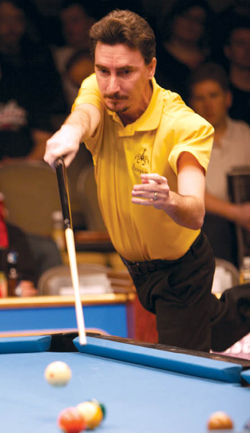|
|
Current Issue
Previous Page Page 4 Next Page
>
Learning Body Language
Johnny Archer
 |
When it comes to exploding into and through the cue ball, it's tough to top Johnny Archer. The Hall of Famer maximizes power by throwing his full weight into the break, finishing with a huge follow-through like none other.
YOU'RE NOT going to go from flyweight to heavyweight in one practice session. Take small steps as you incorporate your body.
1. Start by Transferring Your Weight
Although Deuel recommends approaching the break as any other shot in terms of what you want to achieve, Archer is quick to point out that things change in terms of physically executing the shot.
"Trying to break with your normal stroke isn't going to work," Archer says. "You can't just say, 'Well, I'll just swing my arm as hard as I can.' No matter how strong you are, you need to get your body involved."
But that doesn't mean you should start launching yourself halfway across the table. Take things slow. Start by working on transferring weight from your back foot to your front.
"I don't think the average player should start swaying back and forth," he says. "Instead, it's more about shifting your weight. When you bring the cue back, you want most of your weight on your back foot. As you move the cue forward into the stroke, shift your weight onto your front foot."
Archer suggests starting with a little bit more weight on your back foot, say 60 percent. If you maintain your contact point on the cue ball and the cue ball squarely hits the 1 ball, you're in sync. But if your cue tip or cue ball wanders, something's amiss.
"It doesn't matter how hard you hit them, you got to hit the 1 ball square," Archer says. "Once you get that, where you're hitting it where you want, then you can increase your power."
2. Powering Through the Cue Ball
When you've brought the cue back and you're balanced, it's time to stroke.
"You want to feel like your cue is going through the cue ball and into the 1 ball," he says. "That will help you keep the cue where it needs to be. Above everything else, you need to stay accurate."
As far as keeping your grip hand, cue, legs and upper body all in proper alignment, it's all about timing. Again, work up incrementally, incorporating a bit more of body movement while still striking the cue ball accurately.
"Your hand is going to be faster than your body, but you don't want to get your hand ahead of your body," Archer says. "Everything has to work together. If you can get to where you can hit the 1 ball squarely and control the cue ball, then you pick up the power."
3. And For the Follow-Through
Finishing with his extended follow-through, Archer explodes through the cue ball and continues across the table.
"If I just continue to let the cue go, it makes it much easier to put more power into the shot," he says. "If I stop my cue, it stops my body. I really need to let things flow. So by exaggerating my follow-though, it makes it easier for my body to continue forward. It allows everything to stay on time."
 |
Take a look at the photo to the right. Until you're cracking 'em open like Archer, you might not need to extend your cue that far. But let the power of your stroke dictate how far the cue continues after contact.
4. When In Doubt, Stay Compact
If you feel like something isn't right, shorten the distance between your bridge hand and the cue ball, perhaps as close as 4-5 inches. But beware: When you move your bridge closer to the cue ball, your grip hand has to move forward the same distance to keep your hands matched up.
"You really want to keep thing compact," Archer says. "You lose a little bit of power. But once you're hitting the 1 ball squarely again, you can start loosening up a bit. But if you stay compact, you can't get in too much trouble."
Think of it like a hitter choking up in baseball: It might be a little more difficult to hit one out of the park, but you've got more control of the bat as it goes through the strike zone - and a double always beats striking out.
Previous Page Page 4 Next Page
>
Top |
|





